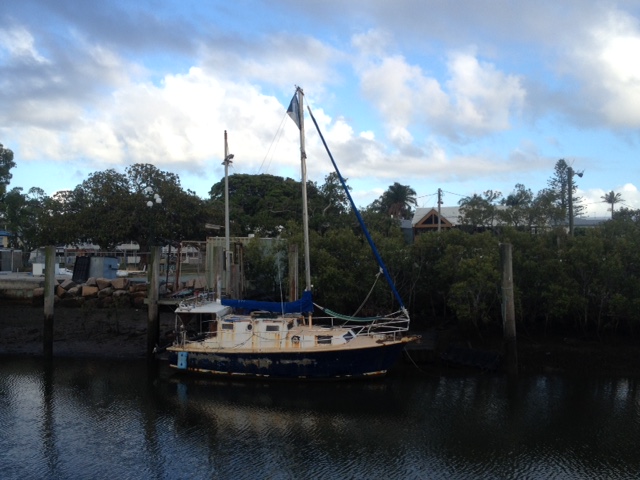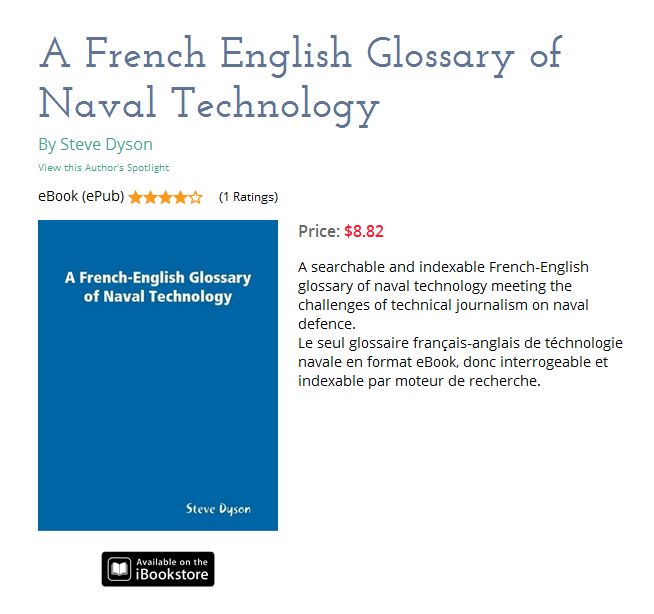
Because this is another post hot on the heels of the first on the topic of terminology, another preamble is called for, in the form of a couple of anecdotes. These two brief stories are merely representative of the type of things many translators do say to illustrate the clean, crisp certainty possible as a consequence of careful and thorough research.
Preamble
If I turn back the clock about three years, I find myself seated at a dinner table at a translators’ conference next to a young women and her colleague representing a translation agency as what the trade terms ‘project managers’.
‘Who checks your terminology?’ was the mind-boggling question she asked me. I was glad I had my mouth full of food, so that I could finish chewing and swallowing before I replied in measured tones, ‘I do. Who else is there?’ I do not think we understood each other.
If I turn back the clock a further two years, I find myself in conversation with a distinguished retired accountant. We were having tea at his home. He has just finished reading one of a handful of copies in English of The Vine Atlas of Spain and Portugal privately printed by the author. As the translator of this work, I have come to ask him for help from among his contacts to find a publisher willing to publish the work commercially at a time when the world was still recovering from the global financial crisis.
We chatted a bit. He said this and that, then asked me quite directly, ‘Are you willing to go banco on this?’ Without hesitation, I said, ‘Yes’. That was all he needed to know.
Introduction
One translator who certainly does check his own terminology, and has gone banco on it too, is translator and technical writer to the French naval defence community, Steve Dyson. His self-publication on Lulu.com, A French-English Glossary of Naval Technology, gives us all the proof we need of his assiduous attention to detail, and systematic examination of the topic at hand as an aid in the work that he does.
I came across the above gem of a resource when having a miniature rant on Facebook while adapting the English text of a French-English bilingual hotel guide, for which I should have by now compiled a definite list of all the different ways one can convey the concept of ‘in the heart of the city/region’
My mini-rant:
Size matters. When is a ship not a ship? When it is a boat, that’s when. And if the boat looks really big to you (from the picture on the Internet), why not simply go with what the owners of the vessel call it: a paddle steamer?
[An amplified note on boats and ships can be found at the end of this article.]Steve Dyson’s comment:
In such situations I often but by no means always go with what the thing looks like to me or what the owner calls it (provided they are writing in their mother tongue).
He also remarked that he encounters this sort of problem quite often in his line of work, and that various solutions are documented in the above glossary. And so began my delving into the workings of Steve’s glossary, and the artistry involved in translating technical texts, since I purchased the e-Pub version of the book, available for use on multiple devices, and printable, if you so wish.
In brief, this glossary provides a cogent argument for building something worthwhile for your own practical reference within a specific subject field. Such glossaries are far more dynamic than is initially apparent. I know this from my own humble experience, although I have never spent 15 years on making one glossary! The dynamism occurs in making them, adding to them, refining them, and proving their usefulness to you as an individual translator in ways which CAT-tool TMs and termbases can only do if you are a TM and termbase genius, which few of us are.
As I give my impressions of this work below, I hope to show you that the method used by Steve Dyson results not only in a useful reference tool, but also enhances your knowledge in real terms of the subject at hand. A glossary such as this one could conceivably be incorporated into a term base of your own, but in any case the work involved in producing one will determine what kind of glossary is most useful to you and whether transfer to a digital base would provide you with the kind of leverage to make it worth the effort.
Let me state right now that my interest in naval technology is minimal. My chief interest is in the ‘glossary’ part of the title. Perhaps now is a good time to issue a gentle reminder that the best terms are not always found in a CAT tool.
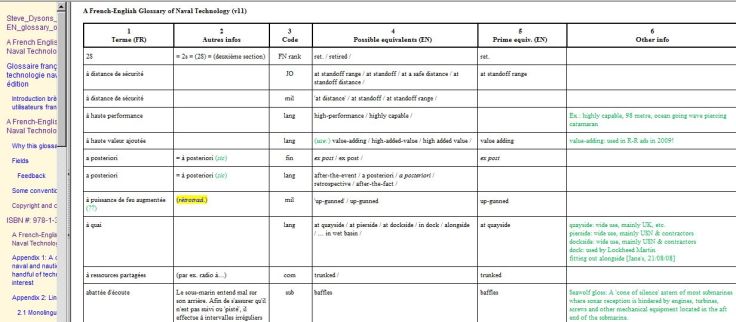
At first glance, you might think you are looking at yet another Excel format term list. Not so. I like the way each column is a continuation of, almost an embellishment, upon the previous one. This is not some fanciful impression; it is intentional on the part of its author, who is careful to explain ‘why this glossary is the way it is’. I have taken the liberty of quoting it almost in its entirety here:
Why this glossary is the way it is
This glossary is the result of over 15 years of into-English translation/adaptation of technical journalism promoting the corporate image, products, services and capabilities of French naval defence contractors. It is highly specific as to subject matter, source document type and translation strategy. For further information on the author’s approach to the translation and adaptation of technical journalism and other documents promoting a client’s products and image to a technically competent readership accessing information in English – an approach known as ‘translation by emulation’ – please see my blog Translation Technical Journalism.
Glossary entries are primarily the result of terms encountered in the course of translation work or, less frequently, in the course of related reading. No attempt has been made to be exhaustive.
This glossary:
- groups ancillary information in French under the column heading ‘Autres infos’ and ancillary information in English or French, depending on the source, under ‘Other info’
- features ‘possible’ and ‘prime’ equivalents in columns 4 and 5, respectively
- is a work in progress, albeit advanced, hence the question marks, blanks and other imperfections.
The clusters of often closely related entries corresponding to a single concept are the result of the author’s attempts to record the often extreme terminological variability in the source documents. Capitalised variants are included to ensure success when the file is used in conjunction with capital- and accent-sensitive indexing and search engines.
In addition to standard equivalents, the ‘possible equivalents’ column includes terminology drawn directly from articles by English-mother-tongue technical journalists, equivalents used by the customer’s partners and competitors and, on occasions, entries leading to metaphors or other devices needed for ‘translation by emulation’. This is a significant departure from the conventional notion of terminological equivalence. Caveat utilitor (let the user beware) applies. The user must analyse and understand the equivalents for what they are, and where necessary conduct further research to determine how to use the information presented here.
For more on the approach to translation, adaptation and transcreation that gave rise to this glossary, work samples & more, see:
•Blog: Translating Technical Journalism
•Approach:Translation by emulation, take #1 + Translation by emulation, take #2
•Work samples, technical:Show ’em what you can do #2 to Show ’em what you can do #11.1 or Turning a problem passage into a gem
•Books translated:Work samples, books
•Work samples, other:Je vais passer pour un vieux con, #2
•Contributor to:101 Things a Translator Needs to Know by WLF Think Tank.
One thing which strikes me about Steve’s glossary is the inclusion of seemingly ordinary phrases with seemingly ordinary target language equivalents. Until you continue reading the entries below these ´straight-forward’ terms. That is when a little of the underlying complexity of this glossary of naval technology becomes apparent. The entry for ‘pilotage’, and those below it, is a good example, although there are many others.
(An aside —I might as well point out the ´yellow ‘retrotrad.’, or retrotranslation, tag which is applied where Steve Dyson has identified that the term used in French is a translation of the English translation, and not the correct, or usually used, term for that referent. While our multicultural global environment does play a part in the adoption of foreign phrases where perfectly good native terms already exist and have been firmly established, one can attribute the appearance of some these retrotranslations not so much to insufficient terminological knowledge on the part of the translator into French but to the lack of confirmation to date of the term in question in an authentic and reliable mother-tongue document.)
Back to ‘pilotage’:
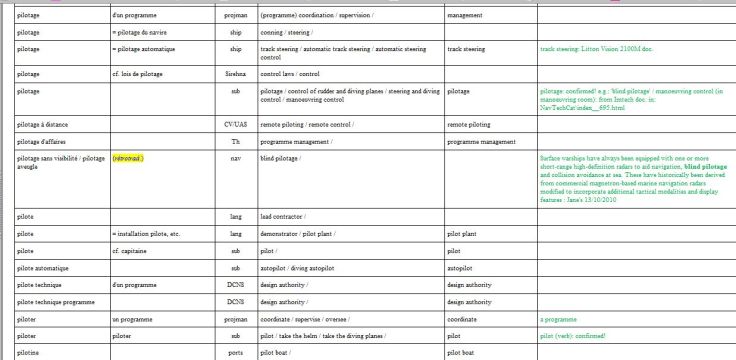
I imagine that in certain cases the entry for the usual, stock phrase translation in general texts (which might be only slightly different) is very specific in the world of naval technology. I also know from the translation and revision of large projects that a quick reference to a very precise term in your own glossary can be more useful than the concordance in Trados, or translation memory. A 95% match with precisely the term you are seeking to avoid will not help you any. Adding both similar variants with very different meanings in both source and targets will be equally unhelpful. So, once you have the best translation of the term, it is a jolly good idea to keep it.
The purveyors of CAT tools and in the last several months have fallen in love with telling us repeatedly a load of nonsense which slides off their tongue as easily as an egg fried in too much oil slides out of the pan and on to the plate, and is about as palatable. They are now fond of telling us that the translation workflow has become ‘more complex than ever’.
The translation workflow has only become more complex because the vendors of certain CAT tools have made it so specifically to ensure that the public at large continue to swallow the half-truth that CAT tools speed things up despite the ‘complex workflow’ and make things easier, and therefore cheaper. For whom? Granted, there are advantages, and I have considerable material I would like to create a termbase with, but if the end result of weeks of work is that it could save me half an hour in a month, then I think the cost-benefit ratio is a bit too squiff to motivate me.
The problem with so many adverts promoting CAT tool terminology management is that they focus on consistency. I heartily support the idea, although find insistence upon consistency strange because such consistency is not always present in the source and, it could be argued, is therefore not imperative in the target. In many texts, including those where the proportion of ‘technical’ content is relatively high, consistency is not always desirable, and this is where a glossary which lists two or three target options next to one source head word is much more helpful than anything one’s TM might contain.
What the purveyors of CAT tools purposely fail to mention is that terminology, although important, is only one aspect of the translation process. The general public are unaware of what translators commonly acknowledge amongst themselves, namely that in order to be effective, use of a CAT tool needs must be accompanied by human subject knowledge and the capacity for discernment as to context.
A CAT tool is just that: a tool. A glossary of the kind Steve Dyson has created is also a tool; a bespoke tool. I asked Steve whether he used a CAT tool. He replied that he had indeed imported columns 1 (source term) and 5 (prime equivalent in target) of his glossary into LogiTermPro’s termbase, but the hit rate had never justified the effort and he hardly ever activates LogiTermPro while working. For Steve’s type of work which demands what he calls not transcreation, but translation emulation (referenced above), the combining of the physical and digital has not been the best solution for him, but I suspect that many with different experience of the digital and different requirements in their work may well be able to do so to satisfaction.
I find my own CAT tool useful, and would not like to be without it. In sharing my impressions of Steve’s meticulous glossary, I am merely advocating the active discipline of performing glossary work of our own of a similar nature as a dynamic adjunct to our pursuit of excellence in our craft. I am recommending a return, however brief, to the more rigorous practice of Steve’s published example in order to bring a more comprehensive architecture to our own terminological knowledge, which has direct benefits as regards our translation skills and the facility with which we can produce better texts.
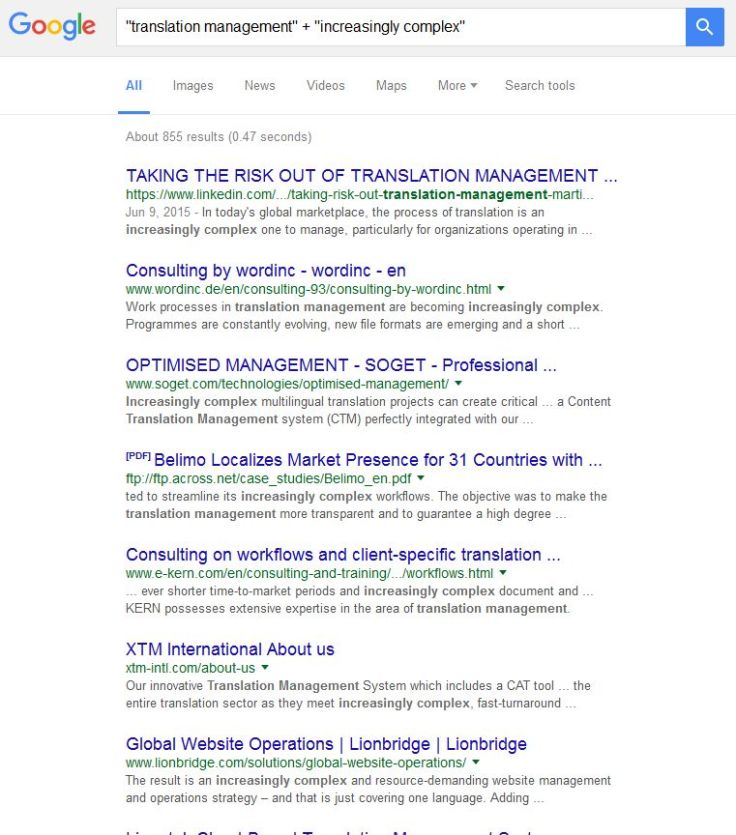
On a lighter note, I was delighted to see that Steve, like me, gets rid of those annoying brackets in French when riding the crest of a high, wild wave with the wind in his favour, well on his way to seeking safe harbour in la version anglaise. I have transcribed a short passage into Trados format, which is an altogether different form of boilerplate, for those of you unused to seeing a paragraph of French above, with the English below:
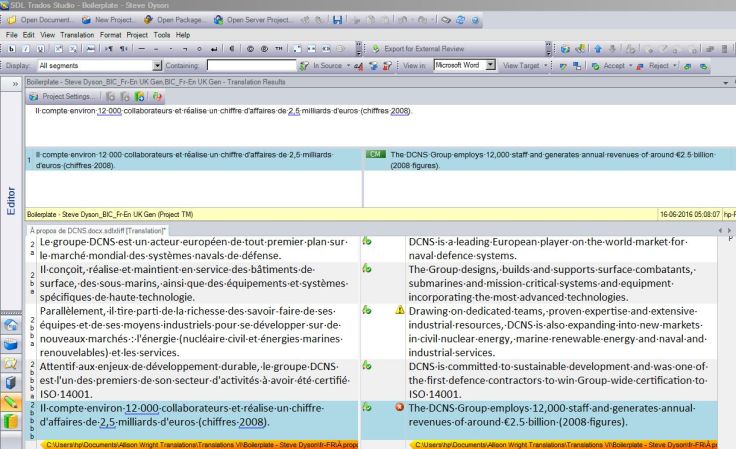
There is more than one way to skin a CAT, as the saying goes, and in this case, a glossary ranks high on my list of priorities.
©2016 Allison Wright
Post script:
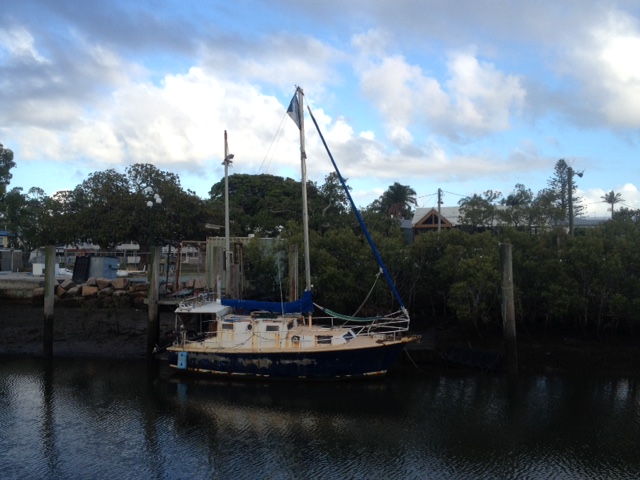
Steve Dyson recently added the following to Appendix 1 of his glossary:
ship vs. boat (naval contexts)
From Military Terminology: Ship vs. Boat
The typical rule of thumb, according to the Naval Education and Training Command, is that you can put a boat on a ship, but you can’t put a ship on a boat. In other words, if there are smaller boats, like lifeboats, dinghies or runabouts that are onboard, the vessel is a ship. Things get more complicated than that – cargo vessels on the Great Lakes are commonly referred to as boats, despite their very large size – but we’ll maintain our focus on the military.
In the US Navy, every commissioned surface vessel is a ship, from the hulking Nimitz-class aircraft carriers to the tiny Cyclone-class patrol ships, hence the USS (United States Ship) before each of their names (non-commissioned ships wear the “USNS” designation). Submarines, meanwhile, are boats, despite wearing the same “USS” moniker. The reasoning for this isn’t entirely clear, although as is so often the case, it’s naval tradition, which tends to supersede all else.
See also: 7 Differences Between a Ship and a Boat and a collection of notes published by The Guardian under the heading What is the difference between a boat and a ship?
